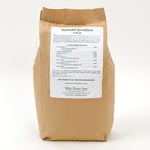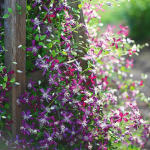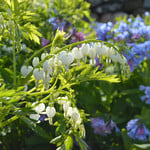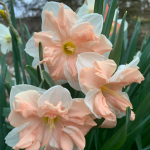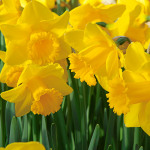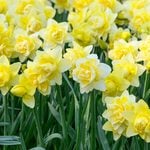Product Details
The Daffodils in this mixture may be diminutive, but they have all won the Royal Horticultural Society's Award of Garden Merit. Many of these Miniature Daffodils are fragrant, and they will provide a long season of bloom, beginning with the early midseason, cream-colored Trumpet ‘W. P. Milner,' followed by midseason 'Minnow,' 'Kokopelli,' and 'Elka,' and finishing with pale yellow 'Angel’s Breath' and 'Sun Disc.' Bulbs are not labeled individually. 25 bulbs cover 2 sq ft. Exclusive.
Daffodils reliably provide the first large flowers of spring, often putting on their colorful show against a backdrop of late season snow. And they are largely immune to voles and deer. Daffodils are easy to grow. They need good drainage and perform equally well in full sun or partial shade. They will also force their way up through turf, turning a banking or a meadow into a garden. Once bloom is complete, there is no need to remove spent blossoms, but do allow the leaves to remain in place until they yellow (6–8 weeks). This ensures the following year's display. We also recommend a top-dressing with Daffodil Fertilizer after planting, with repeat applications every fall thereafter. Follow this regimen and you will be buried in Daffodils, a high-class problem if ever there was one.
Shipping
HOW PLANTS ARE SHIPPED
The size of the plants we ship has been selected to reduce the shock of transplanting. For some, this means a large, bareroot crown. Others cannot travel bareroot or transplant best if grown in containers. We ship these perennials and annuals in 1 pint pots, except as noted. We must point out that many perennials will not bloom the first year after planting, but will the following year, amply rewarding your patience. We ship bulbs as dormant, bare bulbs, sometimes with some wood shavings or moss. Shrubs, Roses, vines, and other woody plants may be shipped bareroot or in pots. The size of the pot is noted in the quick facts for each item.
WHEN WE SHIP
We ship our bulbs and plants at the right time for planting in your area, except as noted, with orders dispatched on a first-come, first-served basis by climate zone. We also ship a wide range of containers and planters, tools, supplies, fertilizers, garden wear, garden decor items, as well as indoor decorations like wreaths and dried bouquets when available. Estimated dates for shipping are indicated in the green Shipping Details box for each item. Please supply a street address for delivery. Kindly contact us with two weeks notice, if you'll be away at the expected time of delivery.
OUR GUARANTEE
We guarantee to ship plants that are in prime condition for growing. If your order is damaged or fails to meet your expectations, we will cheerfully replace or refund it. Please contact our Customer Service Department at 1-800-503-9624 or email us at [email protected]. Please include your order number or customer number when contacting us.
Reviews
Average Customer Rating:
 (4 Reviews)
Write a Review
(4 Reviews)
Write a Review
Sort by:
Tiny and beautiful 
A viewer from Kentucky
7 of 7 people found this review helpful. Do you? yes no Certified buyer
Beautiful 
Daisy from Detroit, Michigan
3 of 4 people found this review helpful. Do you? yes no Certified buyer
Weeks of Performance 
Claremont Garden from Richmond, VA
13 of 13 people found this review helpful. Do you? yes no Certified buyer
cheerful addition to pansy beds 
Fancy Nancy from Atlanta, GA
and colorful cabbage. They popped up in Atlanta in early March and brought a breath of early spring to the garden. I love the fact that they stand nicely upright and never droop with wind or rain.
15 of 15 people found this review helpful. Do you? yes no Certified buyer
Growing guide
Latin Name Pronunciation: nar-sis'-us
Bulb size: 12-16 cm; miniature varieties 8-12 cm
Harbingers of a new season, these spring-flowering bulbs light up the landscape. Glorious gold, lemon-yellow, and snowy white blooms are often accented with contrasting trumpets or centers and vary in height from two inches to two feet with flowers in elegant proportion. Easily grown, the majority of these bulbs are very tolerant of cold winters. Paperwhite Narcissus are hardy only to Zone 8, but are forced indoors in pots in cold climates during the winter months for their fragrant blooms. Many of the hardy varieties can also be successfully forced indoors. Many Daffodils can be grown throughout the South, except in regions that are frost-free, since cold temperatures are necessary for the formation of the flower buds.
Color: Narcissus color can vary based on the age of the flowers as well as environmental conditions, such as temperature and light intensity.
Light/Watering: While Daffodils prefer full sun they will usually tolerate half-day shade, especially Cyclamineus hybrids such as 'Jack Snipe' and the Poeticus variety 'Actaea'. Those cultivars with orange, red, or pink cups generally retain deeper color when planted in a location that receives protection from the hot afternoon sun. Watering during the fall is essential for good root growth before the ground freezes in cold regions. Try not to water excessively in the summer months when bulbs are dormant.
Fertilizer/Soil and pH: Daffodil bulbs will not survive in soils that are wet, especially during the winter. Avoid low-lying areas where water gathers or where the snow is late to melt in spring. Plant each bulb at a depth 3 times the height of the bulb. Daffodil bulbs appreciate deep planting in light soil. If your soil is heavy, try planting less deeply than we recommend, making up the difference with a layer of mulch on top. Plant larger or bedding-size bulbs 5–6″ apart (4–5 bulbs per sq ft), smaller or landscape-size bulbs 3–4″ apart (5 bulbs per sq. ft.), and the miniatures 3–4″ apart (5 bulbs per sq ft). When planting, keep in mind that the blooms tend to face the prevailing direction of the sun; in a border viewed from the north, they will look away from you. Do not separate bulbs that are attached at the base; the smaller bulb (known as an off-set or a "daughter" bulb) should not be detached from the parent bulb before planting. The best time to fertilize is in the autumn, when the bulbs are sending out new roots. To make clumps of Daffodils easy to find, plant a few Grape Hyacinths (Muscari) amongst them; the Grape Hyacinths send up a bit of leaf growth in the fall. The next best time to fertilize is in early spring, just as the Daffodil foliage begins to push through the soil. We recommend using a granular slow-release fertilizer formulated especially for bulbs.
Naturalizing with Daffodils: In naturalizing with Daffodils, begin with the idea that they look best in groups of individual varieties. Mother Nature does it this way, and she is a reliable guide. Plant your bulbs in sweeps or drifts, or scatter them in clumps or clusters. Scatter Daffodil fertilizer over the top of the soil after planting, with repeat applications every fall. Once bloom is complete, allow the leaves to remain in place until they yellow (8-10 weeks). Do not cut back or mow the foliage. This ensures the following year’s display, and they'll reward you with larger clumps each year.
Pests/Diseases: Few if any pests bother Daffodils. The bulbs and foliage are poisonous to most insects and animals, including deer and voles. If you see vertical streaks in the Daffodil leaves, dig up the bulb and put it in the trash as it may be infected with a virus. Watch any surrounding Daffodils for symptoms as the virus is spread by contact.
Companions: Narcissus reach dormancy 6 to 12 weeks after flowering depending on weather and variety. The period between the end of flowering and the withering of the foliage is crucial to the future vigor of the plant. If you cut, fold, or braid the leaves before they have yellowed and collapsed, you may prevent the bulb from storing the energy required to bloom the following year. You can hide curing foliage by interplanting bulbs with leafy perennials such as Hostas, Daylilies, and Ferns or with annuals or ground covers like Brunnera or Vinca. If you plant the bulbs in a lawn, do not mow the grass until the bulb foliage begins to yellow. Daffodils do well under deciduous trees, but avoid planting under evergreens and in areas where large roots are close to the surface.
Dividing/Transplanting: The best time to move or divide bulbs is when their foliage has withered, signaling the end of active growth. Lift them with a digging fork or a spade, taking care to avoid injuring the bulbs, and replant them immediately at the same depth and about three times their diameter apart. Water well.
End of Season Care: Remove dried up foliage after it has died down completely. A mulch of evergreen boughs after the ground freezes may help plants stay dormant if warm periods occur during the winter months.
Calendar of Care
Early Spring: Fertilize now if you missed the fall opportunity.
Late Spring: Water if the season has been dry, and deadhead as needed. Watch for vertical lines in the foliage and remove and destroy any bulbs showing signs of viral infection.
Summer: Try not to overwater in areas where Daffodils are planted. Allow foliage to cure naturally without intervention.
Fall: Use a granular slow-release fertilizer to feed Daffodil bulbs now. Gently lift and divide clumps of bulbs now. Plant new bulbs and include a few Grape Hyacinths to mark the planting spot. Remove dead foliage, and mulch with evergreen boughs after the ground has frozen. Water bulb plantings thoroughly through the fall if rain is scarce.

